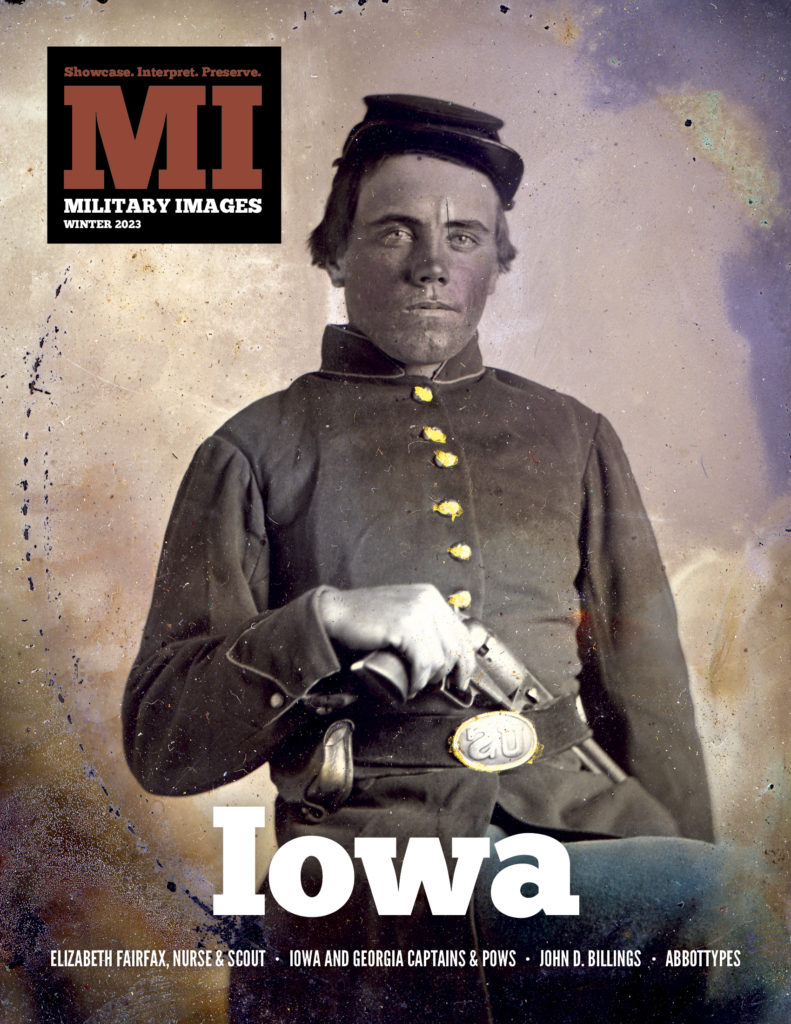A complete table of contents for the Winter 2023 issue of Military Images magazine, and information about how to purchase single issues and subscriptions.
Vol. XLI, No. 1
(80 pages)
Print edition: Visit our store to check availability
Digital edition: Visit JSTOR.org to purchase
Subscribe or renew your subscription
Explore the MI Archives:
Browse | Advanced search | Tutorial
Inside
Cover
A sixth-plate tintype from the Michael Huston Collection pictures John Wesley Morton of the 19th Iowa Infantry.
Table of Contents (p. 1)
Editor’s Desk (p. 2)
“Connoisseur” is usually applied to the art historian or the sommelier. It is also an apt term to describe collectors of historic images.
Mail Call (pp. 3-4)
Feedback includes praise for the recent Illinois issue, a possible Mississippi uniform identification, and a note about Confederate Brig. Gen. Lloyd Tilghman.
Military Anthropologist (p. 4)
A survey of advertisements of photograph albums in newspapers.com from 1860 to 1869 shows the rapid rise in popularity of these items.
Passing in Review (pp. 6)
A review of The Atlanta Daily Intelligencer Covers the Civil War by Stephen Davis and Bill Hendrick (University of Tennessee Press).
Photo Sleuth by Kurt Luther (pp. 8-10)
A portrait of a soldier in the 48th New York Infantry in the Library of Congress collection had two legacy identifications. Which is correct? The author investigates.
Antebellum Warriors (p. 12)
An ambrotype of a seafarer wears a uniform that may be that of a Revenue-Marine Service sailor. Revenue-Marine became today’s U.S. Coast Guard.
Most Hallowed Ground (p. 14)
Andrew Geddes of the 8th Iowa Infantry made captain at age 18 and lieutenant colonel at 21. He went on to a regular army career that tarnished his reputation.
The Honored Few (p. 16)
1st Lt. James Hill of the 21st Iowa Infantry crossed into rebel lines and encountered enemy pickets. How he managed to escape resulted in the Medal of Honor.
The Citizenry by Ross J. Kelbaugh(p. 18)
In “a Forgotten ‘Veteran’ Remembered,” the author pays tribute to Elizabeth Fairfax, an escaped slave connected to the 26th Iowa Infantry.
Fakes, Forgeries and Frauds by Perry M. Frohne (p. 20)
A dealer’s wishful thinking to turn a portrait of a Union captain to Brig. Gen. John Buford is a lesson in getting a second opinion.
Hawkeyes! Faces and stories of Iowa Volunteers in the Civil War curated by Michael Huston and introduced by Robert Welch (pp. 23-45)
Representative portraits and stories of Iowa men who served in the Union army and fought at Shiloh and other Western Theater battles.
A Captain for a Captain: A forgotten act of honor connects two prisoners of war, one from Georgia and another from Iowaby Laura Elliott (pp. 46-48)
In 1871, a Southern captain told a fantastical tale of being released from prison on his honor to find a captured Union captain. Here’s the rest of the story.
Small Miracles: Abbottypes were a bold experiment in mass-produced wearable melainotypes and a unique snapshot of the Civil War in 1861by Ronald S. Coddington and Nick Penachio (pp. 50-60)
Anson and Charles Abbott sold 1860 presidential campaign photo buttons. It went well. After the Civil War began, they tried with military and political figures.
The Army Education of John D. Billings: A letter by the author of Hard Tack and Coffee reveals how his wartime military experience helped him become an educator by Mike Fitzpatrick (pp. 60-62)
After the Civil War ended, Union veteran John D. Billings pursued the education that eluded him before the war. Here’s how he got it, and what it meant to him.
Reminiscences of Collecting Cased Military Images, 1978-2002: Q&A with Kean Wilcox (pp. 64–67)
A large number of Civil War photos from the Kean Wilcox Collection can be found in early issues of Military Images magazine. Here’s the backstory.
Material Culture (p. 70)
The Zouave jacket worn by veterans of the 28th Iowa Infantry has its origins in New Orleans in 1863, suggests a survey of 16 surviving soldier portraits.
Behind the Backdrop: Origins, artistry and photographers by Adam Ochs Fleischer (pp. 72-73)
The author examines Civil War period portrait photographs, with the United States Capitol building and its new dome, in the background.
Vignette: Episodes of the Civil War By Scott Valentine (p. 76)
In “The Water Tiger vs. the Long Board With a Hogshead,” an Indiana soldier describes the 1862 clash of ironclad warships Monitor and Virginia.
Stragglers (p. 78)
Portraits of an uncommon cobalt blue-glass ambrotype, three coatless Union soldiers, and a photograph of a military man of unknown loyalties.
The Last Shot by Michael Huston (p. 80)
The author recounts how Civil War living history helped him pinpoint and unravel the mystery behind the identity of an ancestor in a wartime image.





































